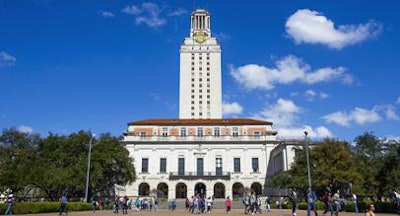 University of Texas at Austin. (Photo courtesy of The University of Texas at Austin)
University of Texas at Austin. (Photo courtesy of The University of Texas at Austin)With the hiring of Shaka Smart as head coach of its men’s basketball team in early April, The University of Texas at Austin became one of only three schools in all of NCAA Division I sports (the others being Georgia State University and Stanford University) with Black men at the helm of both of the school’s revenue sports.
The magnitude of this announcement is amplified by what has been a complicated legacy of race at the flagship Texas institution.
The University of Texas at Austin (UT-Austin) is the university from which three landmark Supreme Court cases on diversity in higher education have been born. These include Sweatt v. Painter, the 1950 case in which Thurgood Marshall would successfully argue against the “separate but equal” precedent set in 1896’s Plessy v. Ferguson case, blazing the way for 1954’s Brown v. Board of Education of Topeka. In Sweatt v. Painter, the court ruled that Heman Sweatt, a Black man, should be admitted into UT-Austin’s law school because the law school at Texas State University for Negroes was inferior.
Then there was Hopwood v. Texas, the case in which the Fifth Circuit Court of Appeals ruled in 1996 that UT-Austin’s law school may not use race as a deciding factor for admissions in order to achieve a more diverse student population. (In 2003, however, the Supreme Court would abrogate this decision in its Grutter v.Bollinger ruling, saying that the “narrowly tailored use of race in admissions decisions to further a compelling interest in obtaining the educational benefits that flow from a diverse student body” was not against the Constitution. In other words, affirmative action practices were acceptable because diversity benefits all students.)
Then, in 2008, Fisher v. University of Texas at Austin again sought to challenge the validity of affirmative action policies at the institution, when a White student, Abigail Fisher, claimed she was kept out of the university in favor of students whose academic credentials were inferior to her own. The Supreme Court remanded the case for further consideration in 2013, and it made its rounds in the Fifth Circuit Court of Appeals. In late June, however, the Supreme Court decided to rehear the case next term.
A complex history
“The University of Texas at Austin plays a major role in the racial history” of the state of Texas and its capital city, Austin, in which the flagship institution lies,” says Dr. Edmund Gordon, chair of the department of African and African Diaspora Studies at UT-Austin.
Gordon often leads a very different tour of campus than the one given by admissions officers. On Gordon’s tour, all of the complicated nuances of race relations on campus—from the buildings whose namesakes were well-known members of the Ku Klux Klan to the histories of the individuals depicted in statues that “line the front door” of the campus—are discussed.
“This campus is heeled around the notion of White supremacy,” he says. “Look at how recently the university stopped being—if it could be said it ever stopped being—an apartheid place.”
Indeed, the history of Black acceptance on the campus, which was founded in 1883, is relatively new. In September 1950, Sweatt enrolled as the first Black student at the UT-Austin law school.
In 1956, the first Black undergraduate student enrolled. Even as they were admitted, Black students were not necessarily welcome; from 1956 to 1964, Black students stayed in dormitories at nearby historically Black Huston-Tillotson College.
Architect Fred Alexander enrolled at UT-Austin in 1960, part of a group that calls themselves “ The Precursors,” the first African- Americans at the university. The campus was still hostile to Black students, he says, but it wasn’t really something he questioned or dwelled upon in his daily life.
“There were those who came prepared to take on segregation,” he says, noting that some of his friends “came in ready to organize” and effect change on campus. But there were others “whose consciousness was not yet there, in terms of race relations.”
“To me, that was just UT,” Alexander says of the racist treatment he experienced on campus. “It was no more, no less than what I expected.”
By the time Dr. Richard Reddick, presently an assistant professor in the College of Education, arrived on campus as an undergraduate in the fall of 1990, the institution was in a vastly different place.
Reddick recalls there was a Black lesbian student body president the year before he arrived, but he says the climate was still complicated, describing it as “definitely a time of tension” on campus.
Forward progress
Today, as the university continues to toil with its racist history, there is an intentional effort to change the climate. There’s the addition of Smart and last year’s hiring of Black head football coach Charlie Strong, even in the face of initial opposition from boosters. There is an even more intentional effort to reflect minority likenesses on campus with the statues of such significant Black and brown leaders as Dr. Martin Luther King Jr. (erected in 1999), Cesar Chavez (erected in 2007) and Barbara Jordan (erected in 2009).
“Slowly the multicultural and multiracial history of the campus is being built into the campus, but the neo-Confederate fabric of the university [remains],” Gordon says. That fabric, he adds, “can’t help but influence who we are, where we are. … It is in the very material being of the university.”
But there are still gains to be made.
“This is a state that’s [roughly] 12 percent Black, and less than 5 percent of the student body is Black,” Gordon says.
Enter Texas’ controversial “10 percent rule,” which guarantees admission to students across the state who finish in the top 10 percent of their high schools and sits at the center of Abigail Fisher’s challenge to affirmative action.
Dr. Leonard Moore, senior associate vice president of academic diversity initiatives and student engagement, says what the 10 percent rule does is “not only … ensure you have a good number of people of color, but it opens up the doors to a lot of poor White students.”
Many on campus say the failure to fully integrate Texas’ K-12 system and overcome the nuances of racism and classism in the state necessitates the continuance of the 10 percent rule in addition to the intentional recruitment of Black and brown students.
“The 10 percent rule wouldn’t work if we had integrated” Texas’ K-12 system fully, says Reddick, a native Texan.
Walking the walk
In spite of challenges to the controversial policy, the school has vowed to remain active in recruiting and admitting students of color to the campus.
When the Fisher case first came down, Vincent says administrators brought the university community “together to let them know” that addressing diversity through initiatives that targeted students of color in general and African-American males in particular was something on which the university did not intend to budge.
“We’re going to adhere to court mandates and we’re going to help students who really need it,” Vincent says. “So it transcends these labels [of affirmative action].”
Gordon says the continued press to intentionally recruit students of color is impressive.
“After the Hopwood case, it’s odd to see a flagship fighting so hard to preserve affirmative action,” says Gordon, referencing the university’s continued fight in the Fisher case.
Beyond recruitment of students, efforts have been made to make the campus an overall more inclusive space.
“I’ve seen a lot of other schools give a lot of lipservice [to diversity],” Moore says. But thanks to a top-down buy-in on the need for diversity, he says he feels UT-Austin is putting its money where its mouth is, literally and figuratively.
“When the president makes [diversity work] a priority, the money starts [flowing],” Moore says, applauding the efforts of President William Powers Jr. and others on campus. “They recognize the value of it. The mission is enhanced when you have people that don’t look alike.”
Once students of color are brought to campus, steps to help them build a home are imperative. Administrators at UT-Austin realized this; an example is the creation of the African and African diaspora studies program.
“In this climate, for a president to say we’re going to create a Black studies program, to do that when there is no pressure [is commendable],” says Moore. “From an administrative perspective, there was no resistance whatsoever to launching new programs or making changes to existing programs.”
In addition to intentionally targeted recruiting of students, key to building a home on campus is identification with faculty and staff of color. There has been a concerted effort, Reddick says, to hire additional Black faculty and staff, thanks in no small part to Vincent, faculty members say.
“There has been a significant increase in Black faculty” on campus since Reddick’s time as a student, he says. “You see Blackness performed in a number of different ways. You don’t have this trope notion of Blackness that you see in the media.”
This is not to say that faculty of color on campus do not experience some of the challenges associated with being dark faces in this historically, predominantly White space.
“One of the biggest challenges we have here as faculty is addressing [White] privilege,” Reddick says. “It’s not enough to say [to potential Black and brown faculty members] ‘come on in’; the structure of the organization has to change.”
Dr. Kevin Foster, an associate professor in the Department of African and African Diaspora Studies, says the privilege shows up in instances as minor as literature selections for class.
Sometimes, as a doctoral student at the institution, Foster would “want to question the appropriateness of texts and overall perspectives, and the professors are like, ‘This is what we’re doing.’
“We have to have a better understanding of the theorist’s ideas when considering his theories,” Foster says. In other words, when considering authors’ works to assign to students, it is important that professors “have an understanding of who these people were in the past and what they were thinking.”
Even still, Reddick appreciates the steps to facilitate a more inclusive environment on campus. Incidents have occurred with students on campus, such as the oft-discussed affirmative action bake sales, bleach bombings (when students of color had balloons filled with bleach thrown at them as they walked campus) and other episodes surrounding fraternities on campus. Reddick, though, says he is “very proud that I work at a university where our president and vice president of diversity” come out strongly and “don’t let things like that slide.”
Gordon agrees. “There is a level of civility,” he says. “There are certainly incidents. … There’s stuff that happens to people on campus.
There’s still a great amount of segregation,” he says, but there is definite progress.
“It’s a very positive place to be a scholar of color right now,” Reddick says. “It’s not perfect, but it’s making progress.”


















